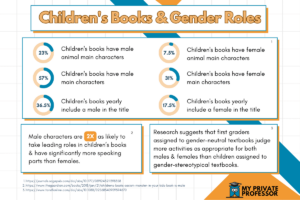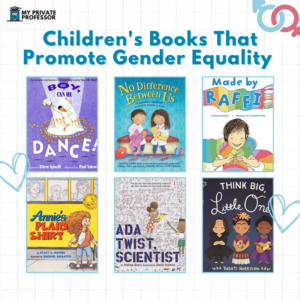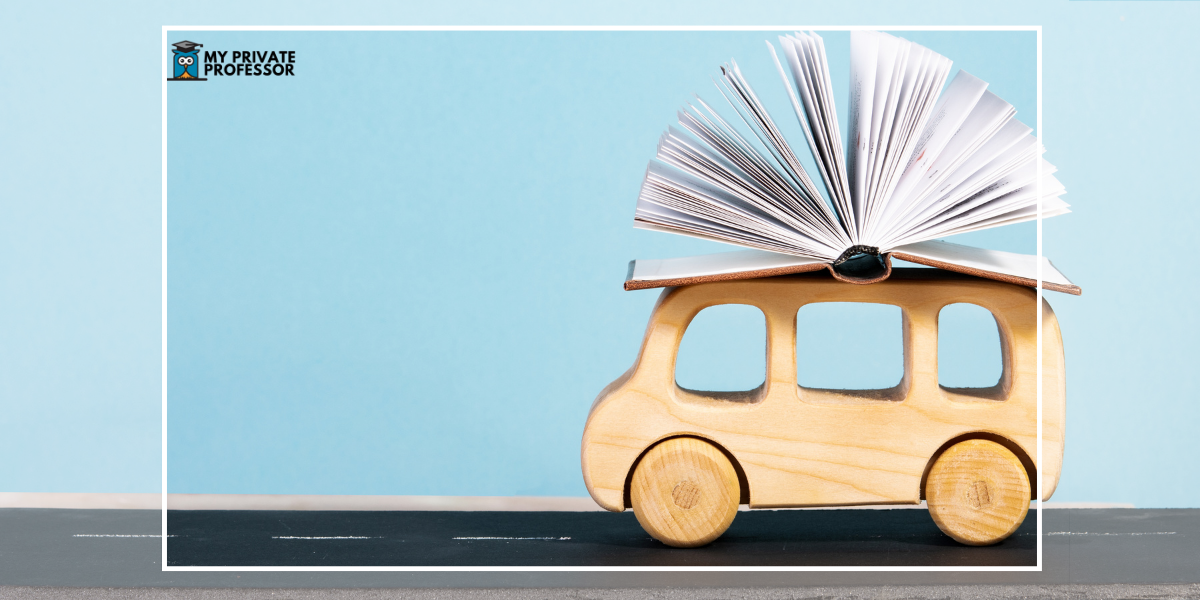When we’re young, we look at the world through somewhat innocent and unknowing eyes. We’re not yet accustomed to many of the things that tend to break down people’s faith in humanity.
That is, younger people are more open to contrasting ideas, beliefs, and theories.
And evidently, with an open mind comes more tolerance, innovation, and creativity. So shouldn’t we be providing children with resources that support this open-mindedness? It seems that in certain areas—for instance, literature—we aren’t doing that.
When you were a child, you probably read books which represented males and females in certain ways. But maybe you didn’t take note at the time (the luxury of being young!). 
If you reflect on some of the stories you came across, maybe you can identify certain common gender stereotypes that consistently pop up, such as:
- Boys are good at math, girls are good at reading
- Masculinity is associated with power, danger, and ferocity
- Femininity is associated with vulnerability and gentleness
What exactly is “gender stereotyping”?
Gender stereotyping refers to the practice of ascribing to any individual traits/skills/characteristics based solely on gender.
For instance, imagine this:
A group of elementary school students are putting together a skit, and one student takes the role of assigning the other students to different characters. They place the girls in the roles of nurses, housewives, and teachers, and the boys in the roles of construction workers, scientists, and doctors.
This is an example of gender stereotyping.
Basic types of gender stereotyping
Generally, there are four basic kinds of gender stereotyping:
- Personality traits: Women are nurturing and emotional, while men are self-confident and confrontational/aggressive.
- Domestic behaviors: Women take care of children, cook, and clean, while men take care of finances, manage the car, and do home repairs.
- Occupations: Women assume the positions of nurses and teachers, while men take jobs as pilots, doctors, and engineers. (nurturing/giving vs. action/doing)
- Physical appearance: Women are thin and graceful while men are tall and muscular.
So these are some of the ways in which we place females and males in certain boxes. And importantly, when we don’t actively resist gender stereotyping, we make it that much more difficult for individuals to venture outside of their boxes.
How do children’s books represent gender roles?
There are a couple of major ways in which children’s books represent gender roles—and we can observe significant patterns in the skewness of these representations.
Gender-specific character traits and careers
For instance, girls are often portrayed as sweet, unassuming, passive, compliant, and dependent characters.
Meanwhile, boys are frequently represented as aggressive, (physically) strong, adventurous, and independent characters.
Accordingly, girls often take on roles such as caretakers, mothers, princesses, and characters to support the boy characters. On the flip-side, you’ll frequently see boys in “active” roles such as fighters, adventurers, and rescuers.
A recent study from Carnegie Mellon University and the University of Wisconsin-Madison found that children’s books do indeed use gendered language when discussing characters.
The researchers found that:
- Books featured female-associated words that relate to affection, school, and communication.
- Books contained male-associated words that relate to professions, transportation, and tools.
- Compared to adult books, children’s books were more likely to associate women with language/arts and men with math.
Importantly, the researchers also determined that, compared to adult fiction, children’s books were much more likely to feature gender stereotypes. This highlights the need for more work confronting gender norms in children’s literature.
One study by Dr. Susan Wilbraham and Elizabeth Caldwell at the University of Cumbria delved into gender representation in children’s science books. The study found that these books featured images of male scientists three times more frequently than female scientists.
The consequence here is pretty clear—neglecting to include female scientists reinforces the idea that science is a heavily-male avocation; as a result, this dissuades young girls from pursuing science.
And in general, placing female and male characters in the specific niches above can be detrimental to young students’ development.
Young boys and girls, that is, will be more likely to comply with these gender categories—boys might think that it’s okay for them to act physically aggressive toward others, while girls may believe that it’s their job to “just take it” when faced with violence or aggression.
Children’s books feature males more frequently than females
In addition to displaying certain stereotypical gender-specific characteristics and roles, there’s something else to look out for:
Children’s books represent male characters a whole lot more than female characters.
A 2018 analysis of the top 100 selling children’s picture books in 2017 by The Observer found that male characters are three times more likely to take leading roles—usually in stereotypically masculine roles—and are given more speaking opportunities than females.
Overall, the number of female characters was lower than that of male characters; specifically, the researchers found that the books on average feature three male characters for every two female characters.
But it doesn’t even stop there.
Children’s books represent non-human characters as males
The analysis also highlighted that only forty percent of the gendered characters were human. The rest were non-human characters (animals, plants, food, etc.). A non-human character was seventy-three percent more likely to be male than female.
In accordance with human male characters, the books featured male-gendered non-human as powerful, wild, and dangerous; and represented as animals such as dragons, bears, and tigers. Contrastingly, the books presented female-gendered non-human characters as smaller and more vulnerable creatures such as birds, cats, and insects.
Finally, something else to consider is that it’s not only the books that perpetuate gender stereotypes. Rather, the adults who read to children may also be impacting children’s views on gender. Research shows that a mother reading a book to her child more often refers to gender-neutral characters as male than female. This in turn promotes the underrepresentation of female characters.
How do gender stereotypes in books affect students?
Books, just like any other form of art or language, can be vehicles for communicating messages pertaining to gender.
Reinforcing self-perceptions
When you constantly see something, regardless of whether it’s true or not, you’ll start to believe it more and more. The repetition frequency bias explains this phenomenon. Specifically, researchers have found that we perceive repeated information to be more truthful than new information—this is called the illusory truth effect.
So evidently, if children continually see characters that share their gender identity in certain roles, they’ll start to believe that these aren’t just projected stereotypes—but that actually, they reflect the true way in which those with that gender identity should act.
Conforming to stereotypes
When young students see characters with their gender consistently showing up in their books, as they get older, they may conform to and perpetuate the stereotypical behavior/traits.
This can emerge in several different ways. For example, when young girls consistently see male characters in STEM careers, they may be less inclined to pursue the field.
In fact, according to the Institution of Physics, only twenty percent of A-Level Physics students are girls.
Evidently, this consequence ranges more broadly than just in science. A 2017 drawing the future report illustrates that by the age of seven, children’s ambitions are molded by gender-related stereotypes about careers.
Limiting the capacity to be open-minded
Another consequence of gender stereotypes in children’s books is that children are actually less likely to seek stories with information/content that reject these norms. And this, to some extent, makes sense.
Biologically, as humans, we’re motivated to seek information that aligns with our current beliefs and information—this is called confirmation bias.
So when children repeatedly see characters portrayed in certain ways, they’re more likely to explore stories with the same “rules”.
And 2018 research confirms this. According to the research, a child is almost two times more likely to read books with a male vs. female lead. In addition, a child is seven times more likely to read a story featuring a male villain than a female antagonist.
How can educators promote gender inclusivity in children’s books?
To help students expand their worldviews & perspectives of their own potential, it’s important to implement strategies to promote gender inclusivity within children’s books. 
Teachers can and should encourage students to venture out of their comfort zones—and one way to do this is by providing reading lists throughout the school year.
One simple tip for educators: use neutral terms for book characters when the author hasn’t specified their gender. Use descriptive phrases instead! For instance, “child in stroller”, “child walking a dog”, etc.
Something else educators can do is to vary the gender/pronoun they use when discussing non-human characters in a book. For instance, if you have a story that features several main characters that are not humans (say, plants) you can alternate different pronouns.
Thirdly, educators can diversify the class library. That is, teachers can spotlight books that transcend the typical gender stereotypes and offer students a more expansive, inclusive outlook.
Final thoughts
If we’re relaying sentiments to young students such as, “You can be whatever you want to be,” the books we’re exposing them to should mirror these messages. Right?
What’s important to remember is that books are more than just collections of words. Really, books are communicative tools that serve as a medium for growth and development.
To say the least, here’s what allowing children to read about and understand multiple perspectives does: helps them to develop empathy, creativity, and open-mindedness.
Books are a gateway to better understanding ourselves, others, and the world around us—and we should celebrate this tool and use it to the best of our ability. Which means embracing books that offer us the opportunity to expand our worldview, perspective, and tolerance for empathy as much as possible.







